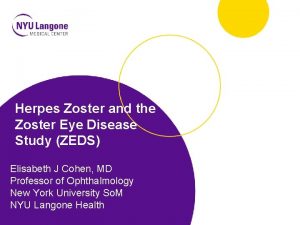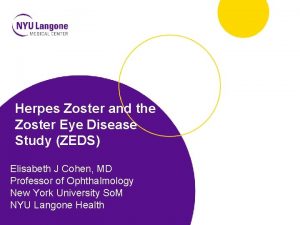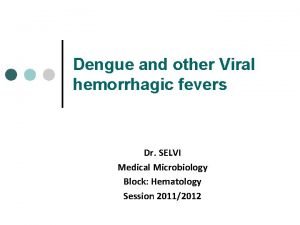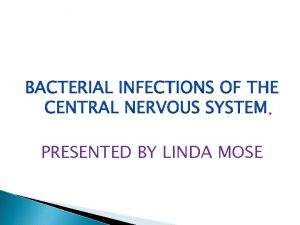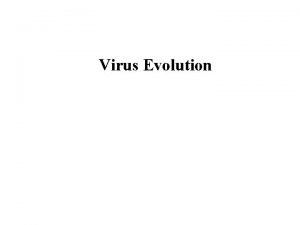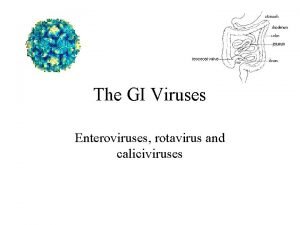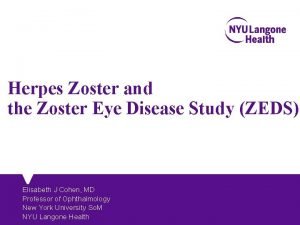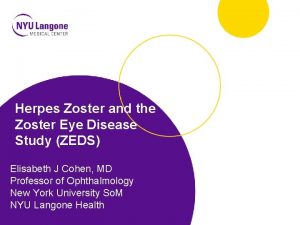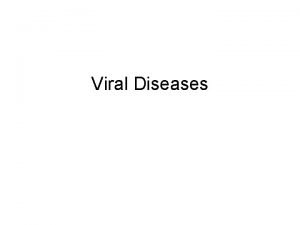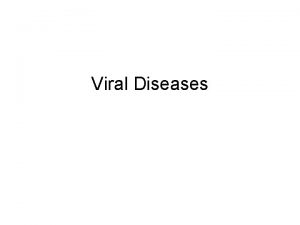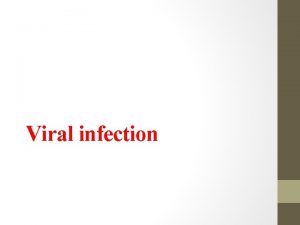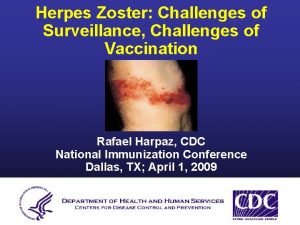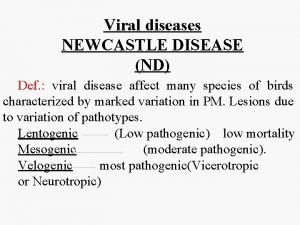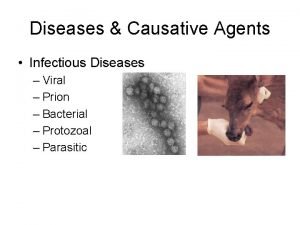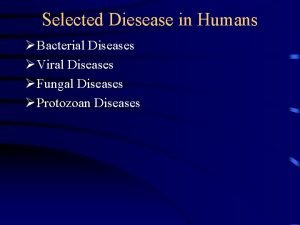Division of Viral Diseases The Challenges of Zoster





















- Slides: 21

Division of Viral Diseases The Challenges of Zoster Surveillance National Immunization Conference Atlanta, GA April 22, 2010 Rafael Harpaz, MD MPH Medical Epidemiologist National Center for Immunizations and Respiratory Diseases Centers for Disease Control and Prevention

Why Herpes Zoster Surveillance?

Why HZ Surveillance? § To monitor impact of HZV program, identify any problems, and allow for refinements § Key elements to track: 1. HZ and its complications: total burden; severity; and distribution of HZ by age and other subgroups 2. HZV effectiveness: against key outcomes, and including duration of protection in specified subgroups (e. g. diabetics, persons over 80 years) 3. HZV safety: including identifying risk groups 4. HZV uptake: to inform actions to remove barriers; identify gaps in age, race, etc. , assess distribution of uptake in order to address biases when evaluating HZV effectiveness

Why HZ Surveillance? § To monitor secondary impact of varicella vaccine (VV) program • Potential impact of VV on persons with prior chickenpox: – Exposure to VZV boosts VZV-specific immunity and may thereby prevent HZ – If so lower VZV circulation due to VV might reduce exposure among persons with latent VZV and increase risk of HZ • Potential impact of VV on persons without prior chickenpox: – By preventing chickenpox (and establishment of latent wild -type VZV infection), VV might reduce risk of HZ

1. Disease Surveillance for Herpes Zoster and its Complications

Disease Surveillance: Challenges § HZ notification not practical (CSTE thus is not pursuing) • HZ cases would not require public health action • Adult providers lack experience with disease notification § HZ generally diagnosed clinically without lab confirmation • Clinical diagnosis: predictive value likely high (unproven) • No opportunity for lab-based HZ reporting • No opportunity to distinguish HZ due to wild-type VZV vs. vaccine strain VZV (is it vaccine failure or adverse event? )

Disease Surveillance: Challenges § Age-specific HZ rates have been changing over time • Reasons unknown • With moving baseline how can we track HZV or VV impact? § Outcome to prevent is HZ pain: can pain be monitored? • HZ itself is not an ideal surrogate for pain since pain of HZ varies by age, and since HZV seems to prevent HZ pain more effectively than it prevents HZ § Most systems would not be timely • Timeliness may not be as important for this program

Disease Surveillance: Strategies § Administrative and claims data (e. g. , Medicare, VA, HMOs) • Large catchment for surveillance and analyses • Caveats regarding use of claims data for surveillance: – Generalizability of denominator population for HZ/HZV – Case-finding limited to those seeking care for their HZ – Validity of codes collected for billing and other purposes – Important variables may not be included in data (e. g. , race, immunosuppression status, co-morbid conditions) – Can claims data be used to track HZ pain?

Disease Surveillance: Strategies § Population-based surveys (e. g. NHIS, BRFSS, other) • True population based data – Can learn more about component of HZ that is not medically attended • Caveats regarding survey data for surveillance: – Accuracy of HZ self-reports uncertain – Huge sample size to track HZ (incidence about 1%)

Disease Surveillance: Strategies § Active surveillance • Sentinel sites (e. g. , Varicella Active Surveillance Project) • Provider networks (e. g. , flu ILINet Surveillance Program) • Advantages: likely more valid than claims data, can track pain, more flexibility regarding variables collected • Caveats: generalizability, catchment size, resources & cost § Special studies based on any of these approaches • Do not yield timely data (timeliness may not be key)

Disease Surveillance: Strategies § Hospitalizations: poor data for tracking HZV program • Only a few percent of HZ cases are hospitalized – Of those cases, HZ is an incidental diagnosis for many and not the cause of hospitalization – Of hospitalizations truly attributable to HZ a large portion are immunosuppressed (i. e. , not preventable by HZV) – Trends in HZ hospitalization are strongly influenced by the prevalence of immunosuppression in the population

2. Assessing Effectiveness of Herpes Zoster Vaccine

Vaccine Effectiveness: Challenges § Challenges regarding surveillance for HZ disease and surveillance for HZV uptake pertain § No lab correlates exist for vaccine protection § Observational studies of vaccine effectiveness are prone to confounding, but studies of HZV are especially problematic: • We know little about factors that distinguish who gets HZ from who doesn’t, who receives HZV from who doesn’t, who gets an immunologic boost from HZV from who doesn’t • Without knowing risk factors, in observational studies of HZV effectiveness, heterogeneity among vaccinees can confound analyses and produce misleading results

Vaccine Effectiveness: Challenges § The physiologic and medical heterogeneity among the elderly (targeted for HZV) is very great Equal risk of HZ? Equal likelihood of vaccination? Equal protection following HZV?

Vaccine Effectiveness: Strategies § Efforts to study epidemiology of HZ, of HZV uptake, and HZV immunogenicity in order to understand related risk factors § As long as large gaps exist in our understanding of these issues, it is not possible to control for key variables so reports regarding effectiveness of HZV should be considered potentially confounded • Analogous to influenza vaccine in the elderly

3. Safety Surveillance for Herpes Zoster Vaccine

Safety Surveillance: Challenges § HZV is first live vaccine targeted to seniors § Since vaccine-strain VZV in HZV remains latent and can, in theory, reactivate at any time, how do we establish time windows to assess safety? § How to distinguish cause and coincidence among the elderly with high rates of medical events (heart attacks, hip fractures, strokes, falls, new detections of cancer or Alzheimer’s disease: which can do we not bother to document? ) § Safety may vary by co-morbidities, multiple medications, and frailty in this heterogeneous population § Adult providers may be less experienced at reporting to VAERS

4. Uptake Surveillance for Herpes Zoster Vaccine

Uptake Surveillance: Challenges § Surveillance for uptake must be widespread and with large catchment to meet the many objectives (i. e. to inform action to correct barriers to uptake, to identify gaps and disparities in uptake, to know who is receiving HZV to interpret performance) § No routine and comprehensive national or state-level systems are in place to monitor uptake of adult vaccines 19

Uptake Surveillance: Strategies § State- or national level surveys (e. g. , BRFSS, NHIS, periodic adult module of NIS) § State- or national level administrative data (e. g. , Medicare Part D, HMOs) § State vaccine registries § Biologic surveillance from manufacturer (doses distributed) § Caveats for these approaches include representativeness and adequate timeliness 20

Thank You!!!
 Que es diagnostico diferencial
Que es diagnostico diferencial Zoster eye disease study
Zoster eye disease study Varicela zoster
Varicela zoster Zoster eye disease study
Zoster eye disease study Herpes zoster clasificacion
Herpes zoster clasificacion Herpes zoster
Herpes zoster Arjan hogewoning
Arjan hogewoning Zostavax reconstitution
Zostavax reconstitution Herpes zoster
Herpes zoster Viral life cycle
Viral life cycle Viral induced wheeze vs asthma
Viral induced wheeze vs asthma Rotarix live attenuated
Rotarix live attenuated Viral
Viral Causes of viral hemorrhagic fever
Causes of viral hemorrhagic fever Andrew lippman mit
Andrew lippman mit Egg inoculation diagram
Egg inoculation diagram Csf meningitis
Csf meningitis Viral recombination
Viral recombination Morfologia viral
Morfologia viral Antiperytique
Antiperytique Replicação viral ciclo lítico e lisogênico
Replicação viral ciclo lítico e lisogênico Viral entry
Viral entry

